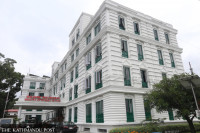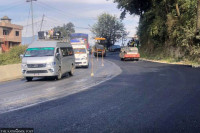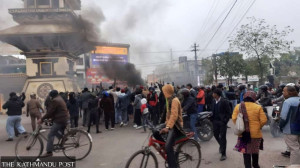National
Nepal witnesses slight improvement in foreign exchange reserves
Nepal Rastra Bank says the foreign exchange reserves are sufficient to cover merchandise and services imports for 8.4 months.
Post Report
Nepal has witnessed a slight improvement in its foreign exchange reserves.
Releasing the current macroeconomic and financial situation based on four months of the current fiscal year, the Nepal Rastra Bank said the foreign exchange reserves increased by 2.5 percent to Rs1246.27 billion in mid-November 2022 from Rs1215.80 billion in mid-July 2022.
In US dollar terms, the gross foreign exchange reserves increased by one percent to Rs9.63 billion in mid-November 2022 from Rs9.54 billion in mid-July 2022.
The central bank in the report said the foreign exchange reserves of the banking sector are sufficient to cover the merchandise imports for 9.7 months, and merchandise and services imports for 8.4 months based on the imports of four months of the current fiscal year.
The government on December 6 decided to lift the seven-month-old ban on the import of “luxury goods” to meet a condition of the International Monetary Fund (IMF) ahead of the formation of a new government.
Earlier in April, alarmed by the fast pace at which Nepal's foreign currency reserve was going down, the government imposed import restrictions besides ordering importers to maintain a 100 percent margin amount to open a letter of credit.
The directive issued on April 26 embargoed 10 types of goods described as luxury items. They included, among other things, mobile sets worth over $600 and motorcycles of over 250cc capacity. Harsher restrictions followed, and mobile sets costing more than $300 and motorcycles with a capacity of more than 150cc were banned.
On August 30, the government loosened the restrictions and permitted the import of diamonds, large television sets, toys, cards, snacks and tobacco.
NRB stated the remittance inflows increased by 20.4 percent to Rs378.04 billion in the review period against a decrease of seven percent in the same period of the previous year. In the US Dollar terms, remittance inflows increased by 10.8 percent to Rs2.93 billion in the review period against a decrease of 7.3 percent in the same period of the previous year.
The report stated that the y-o-y consumer price inflation remained at 8.08 percent in mid-November 2022 compared to 6.04 percent a year ago. Food and beverage inflation stood at 7.38 percent whereas non-food and service inflation rose to 8.63 percent in the review month, the central bank said.
In the review month, consumer price inflation in the Kathmandu Valley, Terai, Hill and Mountain remained at 7.56 percent, 8.52 percent, 8.03 percent and 6.68 percent respectively. Inflation in these regions was 6.14 percent, 5.42 percent, 7.14 percent and 5.00 percent respectively a year ago.




 6.84°C Kathmandu
6.84°C Kathmandu







%20(1).jpg&w=300&height=200)






